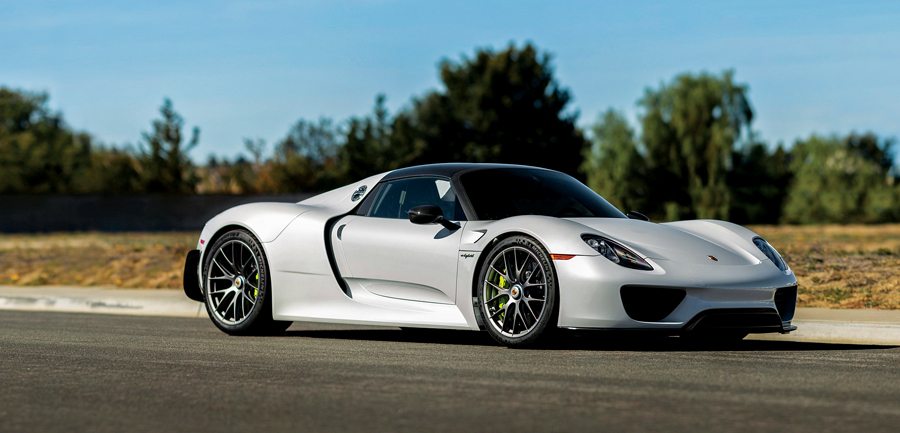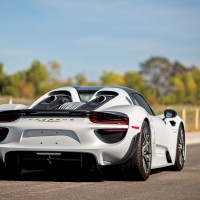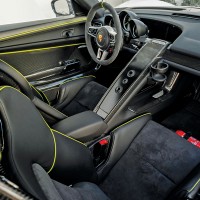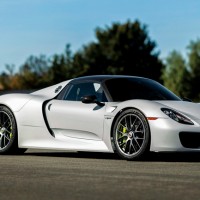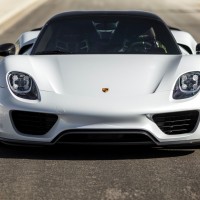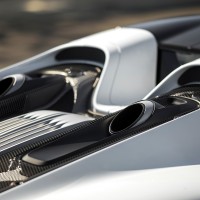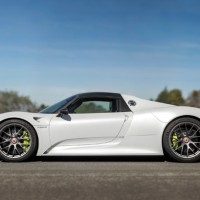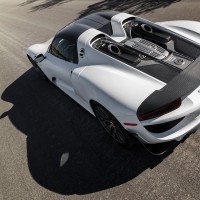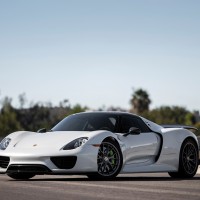This 918
Produced in late 2014 as a 2015 model, this particular 918 Spyder is an incredibly highly optioned example. First and foremost, it is outfitted with the desirable Weissach package, further increasing its performance. Its exterior color is a “paint to sample” Metallic White that is unavailable as a standard color, and the interior is black with Acid Green highlights with Alcantara and seat belts with matching Acid Green accent stripes. Furthermore, the car is fitted with the front-axle lift system, the glare-reducing interior package, automatic air conditioning, Porsche’s wonderful Burmester surround sound stereo system, and the optional cup holder. It was delivered new to the United States and is currently in the hands of its second owner. Sparingly driven, the car’s odometer reads less than 1,500 miles from new. Following a full clear-bra wrap, the car remains in flawless condition inside and out. As Porsche’s most high-tech supercar since the 959, the 918 Spyder is sure to become a future collectible. Yet as a fully roadworthy and capable automobile with four-wheel drive, it is considered by many to be the easiest to drive of the hybrid-hypercar trio and could be driven on a daily basis if so desired.SCM Analysis
Detailing
| Vehicle: | 2015 Porsche 918 Spyder |
| Years Produced: | 2014–15 |
| Number Produced: | 918 |
| Original List Price: | Base, $848,000; Weissach “lightweight,” $929,000 |
| SCM Valuation: | Median to date, $1,677,500; high sale, $1,760,000 |
| Tune Up Cost: | The 918 is self-tuning. A change of spark plugs is $1,831. |
| Chassis Number Location: | Black plaque/silver type on inner front fender |
| Club Info: | Porsche Club of America |
| Website: | http://www.pca.org |
| Alternatives: | 2013–15 McLaren P1, 2013–15 LaFerrari, 2016 Koenigsegg Regera, 2015 Veyron La Finale |
| Investment Grade: | B |
This car, Lot 148, sold for $1,595,000, including buyer’s premium, at RM Sotheby’s auction in Phoenix, AZ, on January 28, 2016.
When Porsche introduced the 918 at the 2010 Geneva International Motor Show, the firm’s newest entry into the supercar market was exciting — but less convincing and motivating than it became later.
Early reports talked about 500 horsepower from the normally aspirated V8 engine, another 250 horsepower from the two electric motors — and a $500,000-plus price. Three and a half years later, at the 2013 Frankfurt Auto Show, the production car was unveiled and reactions warmed.
Porsche buyers are not like the Ferrari collectors who enthusiastically accept any low-production special model the factory offers because it will appreciate and become an instant classic.
Porsche had to work diligently to sell these cars. Enthusiasts did not trust the exotic technology, and the price, nearing $1 million, was off-putting, especially since the 2004–05 Carrera GT depreciated after its introduction.
Porsche outreach was direct and personal to known collectors and previous special-model purchasers. Porsche pushed the car’s exotic specifications and its performance. The first-ever Nürburgring sub-seven-minute lap by a production-series automobile helped. Buyers fell into line. By December 2014, the 918-unit production run was finally sold out, with almost 300 coming to the United States.
What did 918 buyers get?
Owners bought a hyper-hybrid of 887 horsepower, 608 from the 4.6-liter V8 (very loosely derived from the RS Spyder V8) with 279 more horsepower from the electric motors — 154 on the rear axle and 125 on the front —with 994 foot-pounds of torque.
It had a 7-speed PDK dual-clutch automatic. Human shifts slowed it down. Energy storage was via a 312-cell, liquid-cooled, lithium-ion battery, charged both by a plug-in and regenerative braking. The battery pack was warranted for seven years. The chassis was a carbon-fiber-reinforced plastic monocoque.
Car and Driver’s test of the 918 resulted in a 0–60 mph acceleration time of 2.2 seconds, the fastest the magazine had ever recorded, besting the Veyron. The car reached 0–100 mph in 4.9 seconds, 0–180 mph in 17.5 seconds, a quarter-mile in 9.8 seconds and a top speed of 210 mph. The best quote also came from C&D: “Every time you floor it, you get a preview of your first (or next) facelift.”
The magazine noted that application of the hybrid’s prodigious power was seamless and that the 15.4-inch brakes were just as good.
For almost a million dollars
Pricing was $848,000 in base form or $929,000 for the Weissach package that lowered the car’s weight by 80 pounds, largely from substituting interior and wheel materials. $1,000 per pound is now the price for additional exclusivity.
The 918 Spyder is the best ever in the pantheon of Porsche supercars.
There were really only three previous Porsche supercars:
The 959 was first, from the mid-1980s, and it featured very advanced engineering for the era, including computer-controlled 4-wheel drive, aluminum and carbon-fiber panels, and 440 horsepower. Porsche built 337 of them.
The 1998 911 GT1 was a mid-engine two-seater derived from the racing 962 with 544 horsepower. It was a homologation special for its eponymous racing brother. With just 22 road-going examples, it was a step forward in race-car-derived performance, but it was not noteworthy for cutting-edge technology.
The Carrera GT of 2004–05 was next, built in 1,270 examples. It featured a V10 of 605 horsepower based on the ill-fated Footwork Formula One engine.
Historically, Porsche supercars sold over MSRP during the delivery months — and then declined in value. Down the road 10-plus years, those tables turned, and all three earlier cars became highly collectible.
Will this instant appreciation last?
Will the 918 Spyder be a noteworthy deviation? The enthusiastic reception from the motoring press and early owners created escalating demand.
A million-dollar Weissach edition was selling for $1,200,000 to $1,350,000 by the spring of 2015. By the fall they were $1,500,000–$1,600,000 — with asking prices as high as $2,000,000, especially for special-order paint in bright hues.
Today, there are at least 10 for sale in the United States, most in the asking range of $1,500,000 to $1,800,000. Of course, the 918 was introduced into a frothy automobile market. One could easily argue that the market as much as the car created this scene. 959s were also steaming up in price until the 1990 crash.
Our auction result reinforced what we see in the marketplace. Buyers who sought an investment vehicle didn’t want the auction car, as it had 1,500 miles and two previous owners.
Further, the special-order paint was just a variation of white. All things considered, $1,595,000 for this Weissach edition seemed in line. ♦
(Introductory description courtesy of RM Sotheby’s.)
